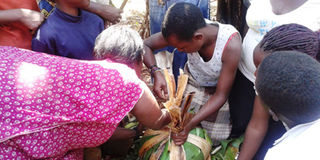Prime
Hot tips on how to prepare matooke

The package before on fire. Wrap in mature banana leaves . net photo
What you need to know:
- UGANDAN STAPLE. Known by different names, matooke is a delicacy that is irresistible.
No meal in Uganda would be complete without matooke. In fact, so taken up are the Baganda with that the word emere (food being the transliteration) means matooke. To be invited to somebody’s home in Buganda or western Uganda and be served pasta, rice and Irish as a staple is downright frowned upon and considered near unorthodoxy.
Such is the love of the Baganda and matooke. I fondly recall my paternal grandmother who would never tire of eating matooke for breakfast in the form of gwolu (cold leftover from the previous night served at breakfast). Lunch and supper, steamed and mashed. And now in katogo form, with a few fingers of matooke, onions, tomatoes, salt, water and ghee.
Only the Baganda would conjure up the idea of giving matooke names and it is commonplace for the matooke vendors to refer to different varieties of matooke with names such as nandigobe, moussakala,kibuzzi, nakyinkyike, and nakitembe. Such is the reverence of matooke that the expression oyo si mere (so and so is not food) meaning that person is only held in high esteem but cannot be taken with levity.
To prepare matooke for steaming as opposed to braising, one has to have endagala (banana leaves) usually sold in bunches or singularly. Make certain that they are reasonably mature of age and the size will depend on the sauce that you choose to use. However, we do not recommend steaming matooke for one or two people though if this is the case then the boiling/katogo method offers the best solution.
What to do with the saucepan
Cut off the stalk extension of the leaf and turn it upside down and with a sharp knife remove and discard the tough midrib making certain the leaf remains whole and intact. Next, fold back the leaf on itself into half and repeat the process for all the leaves that you intend to use. In the meantime, if you have access to the actual stalk of the matooke then cut it into halves and use it to as a foundation in your saucepan. You can also add the stalks and curl them so that they fit in the saucepan.
All in all, they should be piled into the saucepan about ¼ of the saucepan and they will form the support for the matooke as it steams. Select the largest and most mature leaf and place it over the stalks while making sure that you fold it in such a way that it the matooke is wrapped snugly inside. Securely cover the matooke with more banana leaves and add water for steaming that should never be above the stalks to avoid the food becoming watery and possibly discoloured.
Steamed matooke
Ingredients:
•30 to 40 fingers of mature but not ripe matooke
•Several banana leaves and stalks
•Enough water
Method
i)Peel matooke and wash. Prepare the banana leaves as indicated in story.
ii) Have ready a suitable saucepan for steaming and after placing the matooke in the leaf and add enough water. Before placing the matooke in the saucepan, place a couple of banana stalks (ebikolokomba) crosswise in the saucepan. Add the matooke.
iii) Ensure that the matooke is neatly arranged then wrap it with the banana leaves and secure with fibres or ebyai. One by one tuck the banana leaves on top of the other until you are satisfied that they fit snugly. If possible, have a used banana leaf that has been seasoned from cooking matooke and this should be tucked in at the top of the layer of banana leaves.
iv) A gas burner or electric cooker is fine though given the fact that matooke is messy, an outdoor kitchen is advisable and use a sigiri.
v) When you first set the matooke on the fire or cooking range, give it one hour or so of high heat so that it boils thoroughly. After this process, reduce the heat and always make sure that the matooke has enough water and that at all times it is boiling. The process of cooking matooke is via steaming. Allow a minimum of two hours of cooking, the longer the better.
vi) When the banana leaves have turned brown, this is an indication that the matooke is ready to be mashed. Safely remove it from the fire and set it aside.
vii)At this juncture, you will need to have some used banana leaves where you can place the wrapped banana and begin mashing. It helps if you have another saucepan (a small plastic bowl can be used) with cold water and you are now ready to unravel the matooke and mash it using the old banana leaf. Carefully uncover the matooke avoid the steam setting the banana leaves aside. Cut one of the leaves into two and fold the other half into three and the folded leaf gently. Gingerly press the matooke until it is mashed to the consistency of mashed potatoes.
viii) Wrap the mashed matooke in banana leaves and return to the saucepan adding more water making sure that the water does not touch the matooke. Use a wooden spoon (mulao) to pour the water to the bottom of the saucepan.
ix) Return the matooke on the range or sigiri and bring it to boil before reducing the heat and allow it to gently simmer for at least another hour. Without adequate heat you will get poor and dismal results. Serve piping hot preferably in a kibo wrapped in banana leaves.




